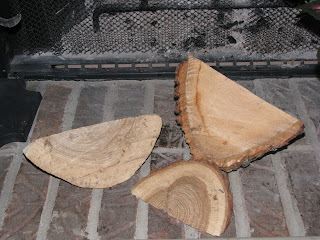It's Spring, and we've been enjoying the outdoors as much as possible, despite high pollen counts. Because I know that once the Summer heat arrives, this Mama isn't going to want to play outside. I'm a wimp that way.
At my daughter's 2nd Grade Easter Egg Hunt at a classmate's grandmother's house, my daughter found a caterpillar and decided she would keep it. She carried it around in her Easter basket for what seemed a long time before finally losing it as she hunted for eggs. Probably a good thing. There was no way she could get it home alive. Caterpillars eat. It's what they do. And for the time it was in her basket, it wasn't eating.
To ease her disappointment, I surprised her (and her sister) with a Live Butterfly Garden kit. It arrived in the mail and we watched our tiny caterpillars grow into large caterpillars.
About 7 days after they arrived, the first one formed a chrysalis, and by the 10th day we had five of them.
As we watched the caterpillars grow and then waited for butterflies to emerge from the chrysalises, we talked about how we would have to release them. And it got me to thinking. What if we created a garden for them? Both of my girls LOVED this idea, and we found the perfect sunny garden spot, an existing garden that needed some new life.
To begin, I researched what plants caterpillars best like to eat, specifically those caterpillars that will become Painted Lady Butterflies, as those are what we were raising. I found that we should have Thistle, Mallow/Hollyhock, Alfalfa, and Pea in our garden. Adult Painted Lady Butterflies especially like Aster and Zinnias.
My initial search at local nurseries turned up empty. So we just started checking labels for flowers that attract butterflies in general and bought some various colors of Lantana, Verbena, Penta, and a Butterfly Bush to get us started. Then I hopped online and ordered Hollyhock and Aster to be shipped to me. Painted Lady Butterflies are common, so I figure once we release them, they'll find what they need to survive and reproduce, even if our garden is not completely ready.
 |
The beginnings of our garden. The plants are young and small,
put perennial (most of them), so we hope in time it will
be a major butterfly hangout. |
My research found that we should place rocks in our garden to give the butterflies a place to rest. A birdbath is not so helpful (even though we have one), as a butterfly cannot rest and drink in a standard birdbath, so we used a small terra cotta drain pan and placed a couple small rocks inside. Hopefully the butterflies will be able to rest on the rocks as they drink from the water. Not that butterflies really need our help to survive.
Once all of our butterflies emerged from their chrysalis, we had to wait several days before we could release them due to bad weather. We fed the butterflies with bits of fresh oranges, fresh cut flowers, and tissue soaked in sugar water.
 |
| Look closely and you might see four of our butterflies. |
 |
| It was nice of them to open their wings for a photo op. |
My daughter's second grade class raised butterflies from caterpillars earlier in the school year. She said that on release day they all took suckers, licked them, and touched them to their finger to get their finger sticky so the butterfly would be attracted and get on their finger. Then when the butterfly was ready, it would fly away.
 |
A neighborhood friend came over and helped us release
our butterflies. |
My oldest daughter and her friend each held a butterfly for about a minute, or so it seemed. My younger daughter's butterfly was more excited about freedom and flew away immediately, not even sticking around for a photo op.
This has been such a fun project to do together. And it continues, because even though our butterflies are gone, we will be working in our garden, watching it grow, and hopefully seeing butterflies and caterpillars able to enjoy it.
Therefore, if anyone is in Christ, he is a new creation. The old has passed away; behold, the new has come. 2 Corinthians 5:17


























